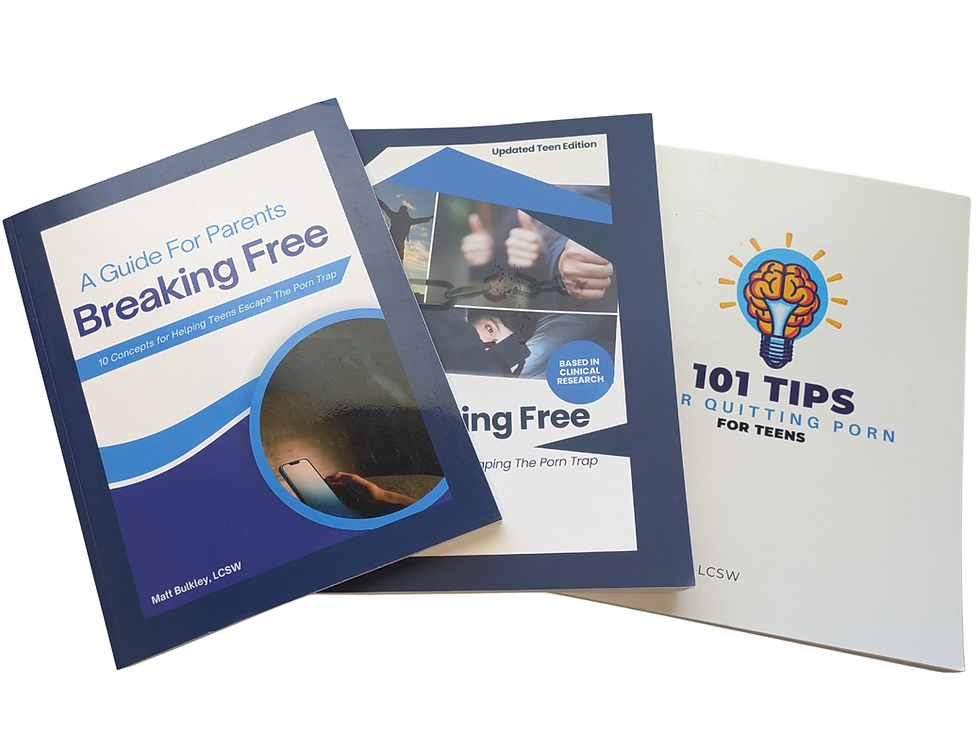Navigating the Perfect Storm: Why Early Intervention is Key for Teens and Pornography
- Matt Bulkley

- Aug 19
- 4 min read
As parents, we want to protect our kids from the challenges of the world, but some battles, like the one against online pornography, feel overwhelming. The statistics are stark and paint a clear picture of a growing issue that demands our attention.
A Look at the Numbers
The digital landscape has made pornography incredibly accessible, and the data reflects its widespread consumption among teens. According to statistics from Covenant Eyes, a company focused on internet accountability, 73% of teens have consumed pornography. This isn't just a niche problem; it's a pervasive one.
The content itself is often more disturbing than many of us realize. A significant number of teens who view pornography are exposed to aggressive and/or violent forms, which can skew their understanding of healthy relationships and intimacy. This exposure isn't just passive; it has a real impact on their emotional well-being. Half of teens report feeling guilty or ashamed after watching online porn, yet many still turn to it.
The age of first exposure is also alarmingly young, with the average age being just 12 years old. This early introduction can lead to long-term issues, as children exposed to pornography are more than three times as likely to engage in problematic sexual behavior later on. This is a critical point: early exposure often leads to more significant problems down the road.
Furthermore, a concerning 45% of teens believe that pornography provides helpful information about sex, creating a dangerous cycle where misinformation is seen as a source of truth. The silence surrounding this issue exacerbates the problem, with 57% of teens having not discussed pornography with a trusted adult. This lack of open communication leaves them to navigate a complex and often damaging topic on their own.
The Science Behind the Struggle: Why Teens Are So Vulnerable
For some teens, this exposure can spiral into a compulsive habit that impacts their mental health, relationships, and self-esteem. The question is, why is it so hard for them to break free? The answer lies in their developing brains.
The prefrontal cortex, the part of the brain responsible for impulse control, decision-making, and critical thinking, isn't fully developed until a person reaches their mid-20s. This biological reality means that teens are literally wired to be more impulsive and less capable of long-term planning or resisting immediate gratification.
This neurological immaturity, combined with the extreme accessibility of online content, creates a perfect storm. The instant dopamine hit from a new video can override a teen's underdeveloped capacity for self-regulation, making it incredibly difficult to break the cycle of addiction, even when they feel the shame and guilt that comes with it.
Why Early Intervention is So Important
The statistics and neurological factors underscore the urgent need for early intervention. Waiting until a problem becomes a full-blown addiction is like trying to put out a forest fire with a water gun. The earlier we address this issue, the better chance we have of preventing long-term harm.
1. Open Communication: Breaking the silence is the first step. Creating a safe space where your teen can talk about their struggles without fear of judgment is crucial. This is where that statistic—57% of teens have not discussed this with a trusted adult—becomes a call to action. You can be that trusted adult.
2. Education Over Censorship: Instead of just blocking access (which can often be bypassed), educate your teen about the realities of pornography. Discuss how it differs from real intimacy, the often-exploitative nature of the industry, and the impact it can have on mental health and relationships.
3. Setting Boundaries: Parental controls and accountability software can be effective tools, but they work best when used in conjunction with open dialogue. These tools are not about control; they're about providing a safety net and a starting point for conversation.
By understanding the unique challenges teens face—both from the content itself and their own brain development—we can approach this issue with empathy and a plan. Early intervention isn't just about preventing addiction; it's about safeguarding their mental health, shaping their understanding of healthy relationships, and giving them the tools they need to navigate the digital world successfully.
Navigating these difficult conversations and finding the right support can feel overwhelming, but you don't have to do it alone. There are numerous resources available to help both you and your teen.
Finding Help and Hope
For many families, the first step is to seek out structured resources that can guide your teen through the recovery process. One such resource is the Recovery Toolbox for teens. This comprehensive kit includes:
The Breaking Free workbook, which gives teens the tools and strategies to understand and overcome their compulsive habits.
The Breaking Free Parent Guide, which provides parents with the knowledge and support they need to navigate their teen’s journey.
The 101 Tips for Quitting Porn workbook for teens, a practical guide filled with actionable advice and encouragement.
Therapy and Outpatient Support
If you're looking for outpatient therapy options, consider a multi-faceted approach. Therapy Associates offers a variety of services designed to help teens and their families. This can include:
A weekly recovery group where teens can connect with peers facing similar struggles.
Individual therapy to address the underlying issues contributing to their behavior.
Family therapy to heal communication breakdowns and strengthen family bonds.
Intensive Intervention
In situations where a teen is facing more serious challenges, such as sexual acting out, dangerous or risky online behaviors, escalating mental health issues, suicidality, or self-harm, a more intensive and structured environment may be necessary. The Star Guides Treatment Program offers a specialized intensive intervention program designed to address these critical safety and risk issues in a safe and supportive setting.
No matter where your family is on this journey, please know that help is available. Taking that first step towards a solution is an act of love and courage.










Comments